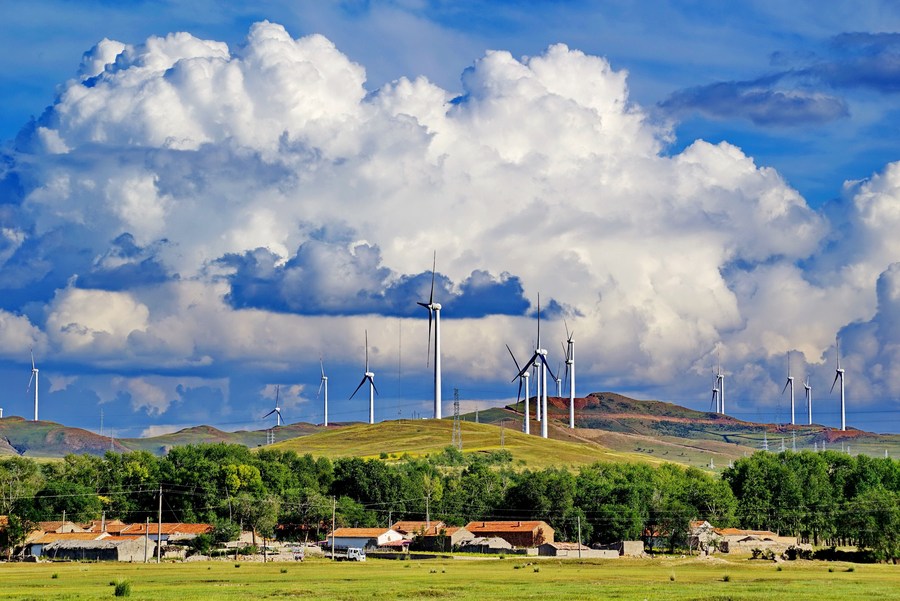Experts hail steps toward energy security


Energy: Clean, secure system is goal
As China actively responds to climate change by following the green and low-carbon development path depicted by President Xi Jinping, curbing coal consumption in a phased manner will serve national interests and guarantee the country's long-term energy security, experts said.
They also emphasized that China will unswervingly honor its commitment to restraining coal consumption.
While addressing the Leaders Summit on Climate via video link from Beijing in April 2021, the president said China will limit the increase of coal consumption over the 14th Five-Year Plan period (2021-25) and phase down coal consumption during the 15th Five-Year Plan period.
Tackling climate change is one of China's major concerns. During a two-day national conference on ecological and environmental protection that concluded on Tuesday, President Xi noted that to promote the green and low-carbon transition in the country's approach to economic growth is the fundamental solution to ecological and environmental issues.
China will strive to build a clean, low-carbon, secure and efficient energy system, and accelerate the construction of a new electricity system, he said.
Xi also presided over a meeting of the Central Commission for Comprehensively Deepening Reform on July 11, which saw the adoption of a policy document to promote the gradual transition from dual control over the amount and intensity of energy consumption to dual control over the amount and intensity of carbon emissions.
It was noted at the meeting that persistent efforts must be made to create the conditions for this transition and to strike a balance between economic development and carbon emissions reduction in accordance with the actual situation.
The experts' remarks coincided with the four-day visit to China by John Kerry, the United States' special presidential envoy for climate. Kerry's visit, which was scheduled to end on Wednesday, came after China suspended climate talks with the US last year following the controversial visit by Nancy Pelosi, then speaker of the US House of Representatives, to China's Taiwan region in August.
Coal consumption is a common concern of China and the US. In a 2021 joint declaration on enhancing climate change actions in the 2020s, they said, "Both countries also recall their respective commitments regarding the elimination of support for unabated international thermal coal power generation."
China announced in 2021 that it would no longer build new coal-fired power projects abroad.
Recently, some foreign media questioned China's resolution to curb coal consumption because of what they alleged were increases in the country's coal consumption, as well as newly approved coal-fired power generation capacity.
Wang Zhongying, head of the Energy Research Institute at the Academy of Macroeconomic Research, said that these reports had no solid data support and failed to recognize the long-term trend of coal consumption in China.
China will have to make arduous efforts to realize its climate targets of peaking carbon dioxide emissions before 2030 and achieving carbon neutrality before 2060, he said. The COVID-19 epidemic, the Russia-Ukraine conflict and volatility in the international landscape have posed more challenges as the country strives to reach the goals.
Against such a backdrop, "fluctuations in coal consumption (in China) are something normal", Wang said. "I hope everyone will look at the trend, rather than just focusing on a certain year or the past one to two years."
With the robust development of solar and wind energy in China, the annual operation hours of China's coal-fired power plants have been declining, Wang said.
China has been leading the world in both speed and scale regarding solar and wind energy development. "On average, the newly developed annual generation capacities for solar and wind energy in China almost cover one-third of the total annual global new capacity. Sometimes, even half," he said.
Meanwhile, the average annual operation hours of China's coal-fired power plants have decreased from the roughly 7,000 hours in the early period of China's reform and opening-up policy, which was launched in 1978,to about 4,000 hours now, he said.
"As the capacities for solar and wind power generation continue to grow, I expect to see the average annual operation hours continue to decline," he said.
Wang also said that to reduce coal consumption doesn't necessarily mean that China must reduce the installed capacity of coal-fired power plants, which are still needed as "peaker" plants that operate during times of high demand, to help stabilize power system operation.
The annual average operation hours of coal-fired power plants in Yunnan province, for instance, have been reduced to about 1,000. But these plants play a significant role in ensuring the stability and reliability of local power systems, he said.
"I suggest that media reporters wait until the end of the 14th Five-Year Plan period or the beginning of the 15th Five-Year Plan period to see the actual progress China has made in (curbing coal consumption). There are only two-and-a-half years to go," Wang said.
Quoting a 2021 study by Princeton University, Li Zheng, dean of the Institute of Climate Change and Sustainable Development at Tsinghua University, stressed the importance of coal-fired power plants for the stability of China's power grid.
The study, which analyzes five pathways for the US to get to net-zero emissions by 2050, said, "To ensure reliability, all cases maintain 500-1,000 GW (gigawatts) of firm generating capacity through all years."
Li said, "Countries across the world all need a stable power source to guarantee the security (of their power systems). For the US, such a power source is electricity generated from natural gas. For China, it is coal-fired power."
Liu Yanhua, honorary director of China's national committee of experts on climate change, said that phasing down coal consumption serves China's own interests.
Currently, coal accounts for about 56 percent of China's energy consumption mix, Liu said.
The nation also depends on imports for 71 percent of its crude oil and 40 percent of its natural gas, he added.
The country boasts almost 207.9 billion metric tons of coal reserves, about 171 billion tons of which are usable. The workable reserve is only enough to be exploited for 40 years, he said.
"China's natural energy reserve condition determines that it must take the path of developing green energy. We urgently need to change," he emphasized, indicating the urgency for China to address its heavy reliance on coal.
- 137 hikers in NW China relocated due to heavy snowfall
- Chinese government to employ 7,000 retired teachers to work in rural areas
- Students and faculty enjoy Mid-Autumn festivities at Nankai University
- Surgical technique developed in China helps thousands abroad
- Liu Yu sends festival wishes for National Day and Mid-Autumn Festival
- Taiwan artist Prince Chiu sends wishes for Mid-Autumn Festival





































